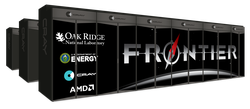A new global high performance computing (HPC) study by Hyperion Research sponsored by Dell Technologies, Intel, and NVIDIA finds evidence of a remarkable rise of sustainability and energy efficiency to the top of priority lists for many HPC datacenter procurement plans, second only to performance, even more imperative than price. A culmination of several geopolitical factors and HPC utilization trends in recent years has made the issue of sustainability unavoidable for many HPC sites.
The 61st edition of the TOP500 reveals that the Frontier system out of Oak Ridge National Laboratory (ORNL) remains the only true exascale machine on the list.
Increasing its HPL score from 1.02 Eflop/s in November 2022 to an impressive 1.194 Eflop/s on this list, Frontier was able to improve upon its score after a stagnation between June 2022 and November 2022.
Join Lenovo, ISC23 Platinum Sponsor, at Congress Center Hamburg (CCH) in Germany from May 22-25 in booth B213. This year, our theme is Smarter is a sustainable tomorrow. Sustainability is a driving force for Lenovo as we develop computing solutions for the 21 st century that enable our customers to solve humanity’s greatest challenges. We are uniquely positioned to guide our customers along their own sustainability journeys because we have begun pursuing our own. This year, we announced our commitment to net-zero greenhouse gas emissions by 2050, validated by Science Based Targets initiative. Strategies for reducing our environmental impact include …
FRANKFURT, Germany; BERKELEY, Calif.; and KNOXVILLE, Tenn.— The 60th edition of the TOP500 reveals that the Frontier system is still the only true exascale machine on the list.
The 59th edition of the TOP500 revealed the Frontier system to be the first true exascale machine with an HPL score of 1.102 Exaflop/s.
The No. 1 spot is now held by the Frontier system at Oak Ridge National Laboratory (ORNL) in the US. Based on the latest HPE Cray EX235a architecture and equipped with AMD EPYC 64C 2GHz processors, the system has 8,730,112 total cores, a power efficiency rating of 52.23 gigaflops/watt, and relies on gigabit ethernet for data transfer.
FRANKFURT, Germany; BERKELEY, Calif.; and KNOXVILLE, Tenn.— The 58th annual edition of the TOP500 saw little change in the Top10. The Microsoft Azure system called Voyager-EUS2 was the only machine to shake up the top spots, claiming No. 10. Based on an AMD EPYC processor with 48 cores and 2.45GHz working together with an NVIDIA A100 GPU and 80 GB of memory, Voyager-EUS2 also utilizes a Mellanox HDR Infiniband for data transfer.
FRANKFURT, Germany; BERKELEY, Calif.; and KNOXVILLE, Tenn.— The 57 th edition of the TOP500 saw little change in the Top10. The only new entry in the Top10 is the Perlmutter system at NERSC at the DOE Lawrence Berkeley National Laboratory. The machine is based on the HPE Cray "Shasta" platform and a heterogeneous system with both GPU-accelerated and CPU-only nodes. Perlmutter achieved 64.6 Pflop/s, putting the supercomputer at No. 5 in the new list.
Although there was a trend of steady progress in the Green500, nothing has indicated a big step toward newer technologies.
The system to snag the No. 1 spot for the Green500 was MN-3 from Preferred Networks in Japan. Knocked from the top of the last list by NVIDIA DGX SuperPOD in the US, MN-3 is back to reclaim its crown. This system relies on the MN-Core chip, an accelerator optimized for matrix arithmetic, as well as a Xeon Platinum 8260M processor. MN-3 achieved a 29.70 gigaflops/watt power-efficiency and has a TOP500 ranking of 337.
Today's data centers consume between 1% and 3% of all electricity worldwide. Over 80% (Reference 1) of this electricity is currently generated by burning fossil fuels, and electricity generation is the largest source of greenhouse gas emissions worldwide. However, data centers continue to expand as new services are constantly being offered to consumers and organizations. Advanced computing technologies that include CPU level generational enhancements, heterogeneous computing, and faster storage and networking enable more complex analytics and simulations to be brought into mainstream workloads.
FRANKFURT, Germany; BERKELEY, Calif.; and KNOXVILLE, Tenn.—The 56th edition of the TOP500 saw the Japanese Fugaku supercomputer solidify its number one status in a list that reflects a flattening performance growth curve. Although two new systems managed to make it into the top 10, the full list recorded the smallest number of new entries since the project began in 1993.
The entry level to the list moved up to 1.32 petaflops on the High Performance Linpack (HPL) benchmark, a small increase from 1.23 petaflops recorded in the June 2020 rankings. In a similar vein, the aggregate performance of all …

